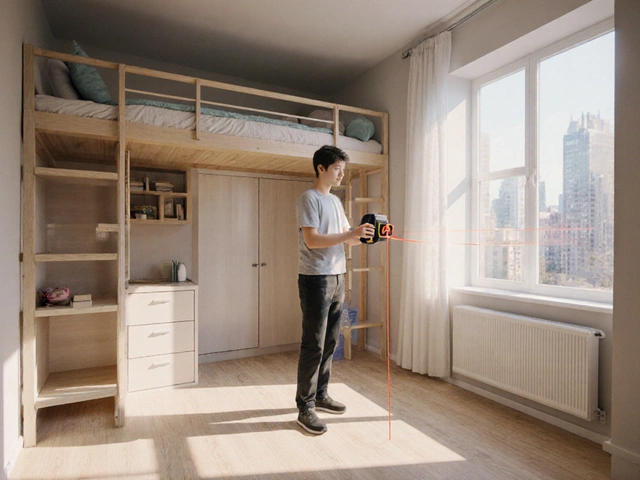5 Rule in Real Estate: How It Impacts Commercial Property Sales

The 5 rule sounds simple, but a lot of people get confused about what it actually means in the world of commercial real estate. At its core, this rule is like a cheat sheet for figuring out if it makes sense to buy a property or just continue renting it. The basic idea: if you can rent a commercial property for less than 5% of its total price per year, renting is usually the smarter move. If renting costs you more than that, buying could be a better investment.
This isn't some magic formula, but it gives you a reason to pause before signing a contract. Think of it as the first filter—kind of like kicking the tires on a used car before taking a test drive. You still need to look deeper at things like taxes, maintenance, location, and financing, but the 5 rule gets you thinking about the money math before emotions take over.
Here's the part too many people miss: the 5 rule doesn't guarantee big profits or protection from bad decisions. It's just a reality check. Plenty of seasoned investors use the 5 rule as a quick gut-check when sorting through listings or negotiating a lease, but they always go further with their research after that.
- What Exactly is the 5 Rule in Real Estate?
- Applying the 5 Rule to Commercial Properties
- Crunching the Numbers: Examples and Scenarios
- Advantages and Pitfalls of the 5 Rule
- When (and When Not) to Rely on the 5 Rule
What Exactly is the 5 Rule in Real Estate?
The 5 rule in real estate is a quick way to help investors size up whether a commercial property is worth buying or if it’s smarter to just rent. Here’s the short version: If the yearly cost to rent a property is less than 5% of what it would cost to buy it, renting usually gives you a better deal. If renting eats up more than that 5% line, it’s a sign buying the property could make more sense financially.
This trick is all about speed—no gigantic spreadsheets or hours of spreadsheet-wrangling. Investors love it because it helps them say "pass" or "maybe" in seconds, especially in busy markets where good deals go fast.
“Rules of thumb like the 5% rule help you keep emotions out of investing. It’s just a starting line—always check the numbers deeper afterward.”
— Joe Fairless, Best Ever Commercial Real Estate Investing Advice Podcast
Here’s the nuts and bolts on how people actually use the 5 rule on commercial property:
- Find the total price (market value) of the building you’re eyeing.
- Multiply that by 0.05 (or 5%). Get the “break-even” number.
- Compare that number to the yearly rent for a similar place.
- If the rent is lower, lean toward renting. If higher, look into buying.
Here’s a breakdown of how it looks in numbers for a $1 million property:
| Scenario | Annual Rent | 5% of Property Price | Suggested Move |
|---|---|---|---|
| Rent is less than 5% | $40,000 | $50,000 | Lean toward Renting |
| Rent is more than 5% | $60,000 | $50,000 | Time to Consider Buying |
This rule got popular when big cities like New York and Dallas saw lease costs jump way above that 5% mark, while property values stayed put. It’s not a perfect science, but for busy investors hunting commercial deals, the 5 rule can save time and help spot good opportunities before anyone else does. Just remember—always double-check with a deeper analysis before you sign anything. The 5 rule helps, but don’t hang your whole decision on it.
Applying the 5 Rule to Commercial Properties
Using the 5 rule for commercial property comes down to one question: how much bang are you getting for your buck? If you know the purchase price of a building and you know the annual rent, this rule makes it easy to see right away where you stand. Here's what you actually do:
- Figure out the price of the property you want to buy.
- Look up how much it costs to lease a similar property per year—make sure it's apples to apples (similar size, location, condition).
- Divide the annual rent by the purchase price. Multiply by 100 to get the percentage.
For example, if the building's price is $1,000,000 and the yearly rent is $40,000, your rent-to-price ratio is 4%. Since that's less than 5%, renting is the better deal according to this rule. If it goes above 5%, buying starts to make more sense. Here's how this shakes out with some real numbers:
| Purchase Price | Annual Rent | Rent/Price Ratio | 5 Rule Decision |
|---|---|---|---|
| $500,000 | $28,000 | 5.6% | Consider Buying |
| $750,000 | $30,000 | 4.0% | Rent is Better |
| $1,200,000 | $72,000 | 6.0% | Consider Buying |
| $950,000 | $40,000 | 4.2% | Rent is Better |
This isn't just for big corporate deals—it works for small businesses too. A lot of people miss out because they either overpay rent thinking property ownership is out of reach, or they rush to buy without checking the real rent-to-value story in their area first. The 5 rule works best when you have solid, up-to-date data. Prices and rents move fast, especially in growing cities. Check new listings, talk to brokers, and refresh your numbers every few months to avoid guessing.
One more tip: don’t forget to factor in extra costs with owning, like repairs, property taxes, and sometimes, the headache of dealing with tenant issues if you buy a place with existing leases involved. The 5 rule is a shortcut—not the whole map—so always still do your homework once you narrow down your options.

Crunching the Numbers: Examples and Scenarios
Let’s get real about how the 5 rule looks with actual numbers. The point here is to compare the annual rent you’d pay with 5% of the property’s purchase price. That’s it. If you can rent for less than 5% of the sale price per year, keep renting. Paying more? Maybe time to think about buying, but don’t stop there—use it as a signal to dig deeper.
Check this out. Say there’s a commercial space with a market price of $1,000,000. You’re offered a lease at $3,500 per month. Jump to the math:
- Annual Rent: $3,500 x 12 = $42,000
- 5% of Purchase Price: $1,000,000 x 0.05 = $50,000
So you’re paying only $42,000 a year in rent when 5% of the price is $50,000. That’s a clue: don’t rush to buy, the rent deal is better on the surface.
| Scenario | Purchase Price | Annual Rent | 5% of Price | Buy or Rent? |
|---|---|---|---|---|
| Downtown Retail Space | $2,000,000 | $120,000 | $100,000 | Consider Buying |
| Small Office | $900,000 | $35,000 | $45,000 | Probably Rent |
| Industrial Park | $3,500,000 | $160,000 | $175,000 | Probably Rent |
Notice how in the first example (the retail space), the rent is more than 5% of the price. In markets with a lot of demand, you’re more likely to see rents blow past that 5% line. High rent? The 5 rule says, pause and look at ownership costs more closely.
Remember, numbers alone aren’t the finish line. The 5 rule misses stuff like future market trends, taxes, or what you might make from appreciation. Still, it stops you from making a snap judgment based on gut feel or pressure from brokers. Use it as your early-warning system when checking out properties and lease deals.
Advantages and Pitfalls of the 5 Rule
The 5 rule is popular because it keeps things simple. At a glance, it tells you if a commercial property makes financial sense to buy or rent, saving you time and letting you filter out duds early. The main advantage? Speed. Investors can quickly compare different listings without drowning in spreadsheets or snoozing through complicated finance models.
There's more: the 5 rule helps investors stay realistic and not get swept up by fancy marketing or wishful thinking. If the annual rent is under 5% of the property's purchase price, chances are the landlord isn’t desperate to sell, so it’s often cheaper to keep renting. On the flip side, when rent tips over that 5% line, it’s usually a sign the price makes buying a smarter long-term choice.
But—it comes with real pitfalls. The biggest issue is that this rule ignores a bunch of real-world costs. It doesn't factor in property taxes, maintenance, insurance hikes, or surprise repairs. Financing variables like interest rates can flip the script, too, especially these days, when average commercial real estate loan rates can range from 6% to 8.5% depending on the deal.
Let’s break it down further with a quick look at what the 5 rule covers, and more importantly, what it misses:
- 5 rule only considers the rent vs. purchase price—not operating costs.
- It skips local factors like market cycles and neighborhood trends.
- No accounting for future growth or property appreciation.
- Doesn't look at the flexibility renting gives (easy move-outs, less money tied up).
To put the pros and cons side by side, here’s a simple table:
| Advantages | Pitfalls |
|---|---|
| Fast decision filter | Ignores ongoing expenses |
| Easy for beginners to remember | Misses financing costs |
| Useful in competitive markets | Lacks market context |
| Works with limited info | Doesn’t reflect every scenario |
The bottom line: use the 5 rule as a quick gut-check, not a final answer. It's a time-saver that can help you spot a deal worth looking into, but it never replaces a full deep-dive before you pull the trigger on a commercial real estate move.

When (and When Not) to Rely on the 5 Rule
The 5 rule is a great quick tool, but knowing when to actually trust it—and when you shouldn't—makes all the difference. Savvy commercial property buyers often use it as a shortcut, but it’s not foolproof. Here’s where using the rule can help, and where you really need to slow down and dig deeper.
You should rely on the 5 rule when:
- You need a fast way to weed out bad deals. For example, if you’re scanning a dozen listed properties and don’t have time to deep-dive every number, the 5 rule helps skip obvious overprices.
- Your market is relatively stable and not prone to sudden swings or special local factors. In cities with steady, predictable rental prices, the 5 rule is almost like a sanity-check.
- You want a consistent, apples-to-apples decision tool between rent and buy decisions over a short list of options.
But here’s when the 5 rule can steer you wrong:
- The area is in a “hot” phase or in transition—think spots where gentrification or a new campus is about to change demand, and both prices and rents move fast.
- You’re looking at specialty properties (like warehouses with climate control, or medical offices). These have unique value drivers and risks, so the 5 rule becomes too blunt.
- You haven’t factored in all costs. The rule is based purely on price and rent, but real-life ownership comes with: property taxes, insurance, maintenance, and maybe big capex (like roofs and HVAC). In spots like New York or San Francisco, those extra costs are serious money.
Don’t forget rising interest rates can also change the logic. When rates shoot up, loan payments eat more cash, and the usual percentage boundaries shift. Here’s a table showing how interest rates impact the rent-vs-buy decision for a $1,000,000 commercial property—the annual mortgage payment usually overtakes the 5 rule rent guideline as rates climb:
| Interest Rate | Annual Mortgage Payment (30 Year Fixed) | 5% Rule Rent/Year |
|---|---|---|
| 4% | $57,240 | $50,000 |
| 6% | $71,640 | $50,000 |
| 8% | $88,000 | $50,000 |
So, bottom line—only trust the 5 rule as a quick filter, not the final answer. If you’re in a complex market, dealing with weird properties, or see big changes coming, dig way deeper before you sign anything.







Write a comment